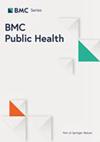Prevalence, sociodemographic risk factors, and coverage of myopia correction among adolescent students in the central region of Portugal
IF 3.6
2区 医学
Q1 PUBLIC, ENVIRONMENTAL & OCCUPATIONAL HEALTH
引用次数: 0
Abstract
Knowing the prevalence of myopia at school age is essential to implement preventive measures and appropriate interventions, ensure access to vision care, promote a healthier educational environment and improve academic performance. The purpose of this study was to determine the prevalence of myopia and its associated sociodemographic risk factors, as well as to estimate the coverage of myopia correction among adolescents in center of Portugal. This cross-sectional study evaluated 1115 adolescents from the 5th to the 9th year of school, with an average of 12.9 years (SD = 1.5) ranging from 10.0 to 18.0 years. Optometric evaluations were carried out in a school environment and consisted of the evaluation of distance visual acuity, assessed using a logarithmic visual acuity chart (ETDRS charts 1 and 2) at 4 m, and measured by refractive error with a pediatric autorefractometer (Plusoptix), by non-cycloplegic. Myopia was defined as spherical equivalent (SE ≤ -0.50 diopter (D)) and uncorrected visual acuity (UVA ≤ 95VAR). Adjusted logistic regression analysis was applied to investigate risk factors. We found a myopia rate of 21.5% and a high myopia rate of 1.4%. Higher school level and attendance at urban schools were associated with myopia, but no association was found with age or sex. Only 34.6% of myopic adolescents use the best optical correction and 26.4% do not use any type of optical correction. Data on the prevalence of refractive problems in Portugal are scarce and heterogeneous. This study, although regional, provides a valuable contribution with a clear and reproducible methodology, following international guidelines and filling gaps in the existing literature. The results show that the rate of myopia in this age group is similar to reports from other European studies. The high rate of adolescents with uncorrected or under-corrected myopia in Portugal is a problem that deserves attention.葡萄牙中部地区青少年学生近视患病率、社会人口风险因素和近视矫正覆盖率
了解学龄儿童的近视发病率对于实施预防措施和适当干预、确保获得视力保健、促进更健康的教育环境和提高学习成绩至关重要。本研究旨在确定近视的发病率及其相关的社会人口风险因素,并估算葡萄牙中部地区青少年近视矫正的覆盖率。这项横断面研究评估了 1115 名从 5 年级到 9 年级的青少年,他们的平均年龄为 12.9 岁(SD = 1.5),从 10.0 岁到 18.0 岁不等。验光评估在学校环境中进行,包括远距离视力评估,使用对数视力表(ETDRS 图表 1 和 2)评估 4 米处的视力,并使用小儿自动屈光仪(Plusoptix)测量屈光不正,测量方法为非屈光参比法。近视定义为球面等效(SE≤-0.50屈光度(D))和未矫正视力(UVA≤95VAR)。我们采用调整后的逻辑回归分析来研究风险因素。我们发现近视率为 21.5%,高度近视率为 1.4%。学校级别越高和就读于城市学校与近视度数越相关,但与年龄和性别无关。只有 34.6% 的近视青少年使用最佳光学矫正方法,26.4% 的青少年不使用任何光学矫正方法。有关葡萄牙屈光问题发病率的数据很少,而且各不相同。这项研究虽然是地区性的,但它采用了清晰、可重复的方法,遵循了国际准则,填补了现有文献的空白,是一项有价值的贡献。结果显示,该年龄组的近视率与其他欧洲研究报告相似。葡萄牙青少年未矫正或矫正不足的近视率较高,这是一个值得关注的问题。
本文章由计算机程序翻译,如有差异,请以英文原文为准。
求助全文
约1分钟内获得全文
求助全文
来源期刊

BMC Public Health
医学-公共卫生、环境卫生与职业卫生
CiteScore
6.50
自引率
4.40%
发文量
2108
审稿时长
1 months
期刊介绍:
BMC Public Health is an open access, peer-reviewed journal that considers articles on the epidemiology of disease and the understanding of all aspects of public health. The journal has a special focus on the social determinants of health, the environmental, behavioral, and occupational correlates of health and disease, and the impact of health policies, practices and interventions on the community.
 求助内容:
求助内容: 应助结果提醒方式:
应助结果提醒方式:


